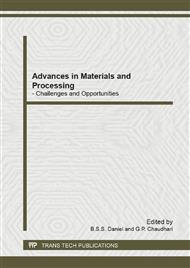p.56
p.62
p.67
p.72
p.77
p.82
p.87
p.95
p.100
FTIR and TGA Analysis in Relation with the % Crystallinity of the SiO2 Obtained by Burning Rice Husk at Various Temperatures
Abstract:
Rice husk ash (RHA), a waste product of the rice industry, is rich in SiO2. The large amount of SiO2 freely obtained from it provides an abundant and cheap alternative to metallurgical grade SiO2 for many industrial applications. The detailed analysis of the physical dimensions such as length, width and thickness of four varieties (HMT, Sonam, 1001 and JSR) was done. The FTIR analysis of the ash obtained by burning rice husk at different temperatures proves the formation of nano SiO2. The study of the isothermal thermal degradation of the RHA was done by TGA analysis .During TGA analysis it was observed that, mass trace suddenly goes backwards along the abscissa and then continues forward normally. This characteristic behavior of the TGA plot was attributed to the formation of nano SiO2 during incineration of the RHA. The minimum value of the percentage crystallinity of the SiO2 at 500°C proved the formation of amorphous SiO2.
Info:
Periodical:
Pages:
77-81
Citation:
Online since:
November 2012
Authors:
Keywords:
Price:
Сopyright:
© 2012 Trans Tech Publications Ltd. All Rights Reserved
Share:
Citation:


